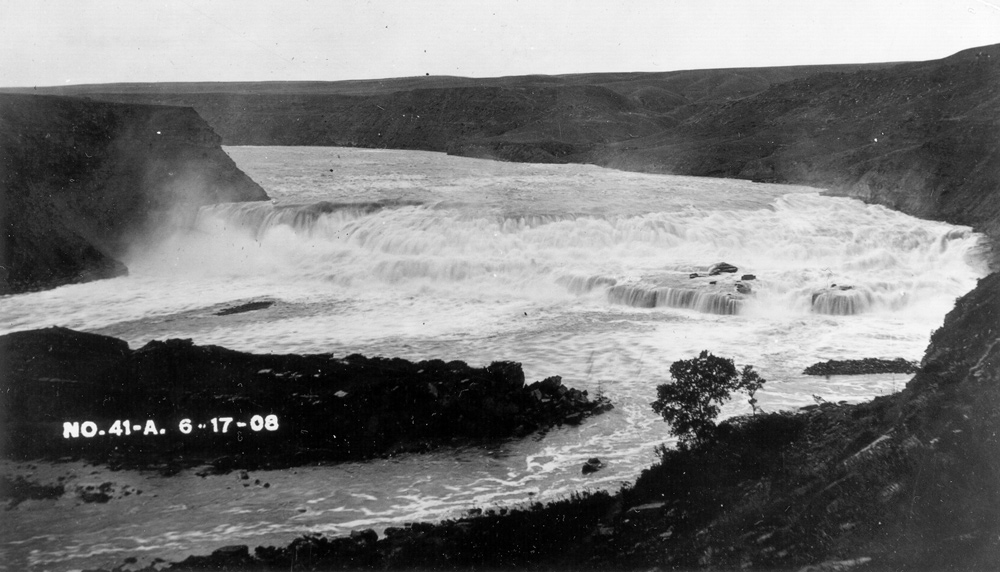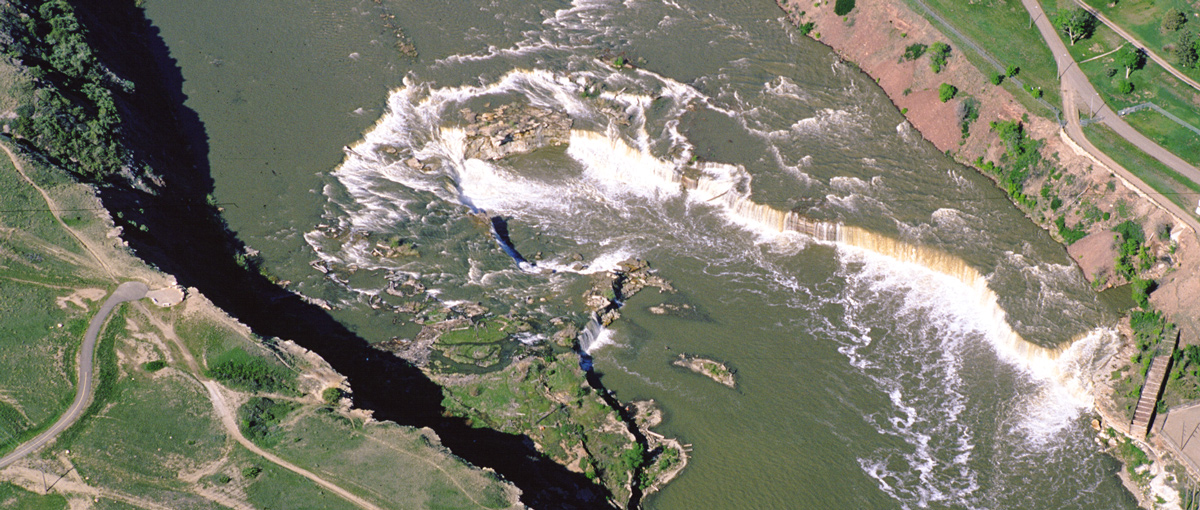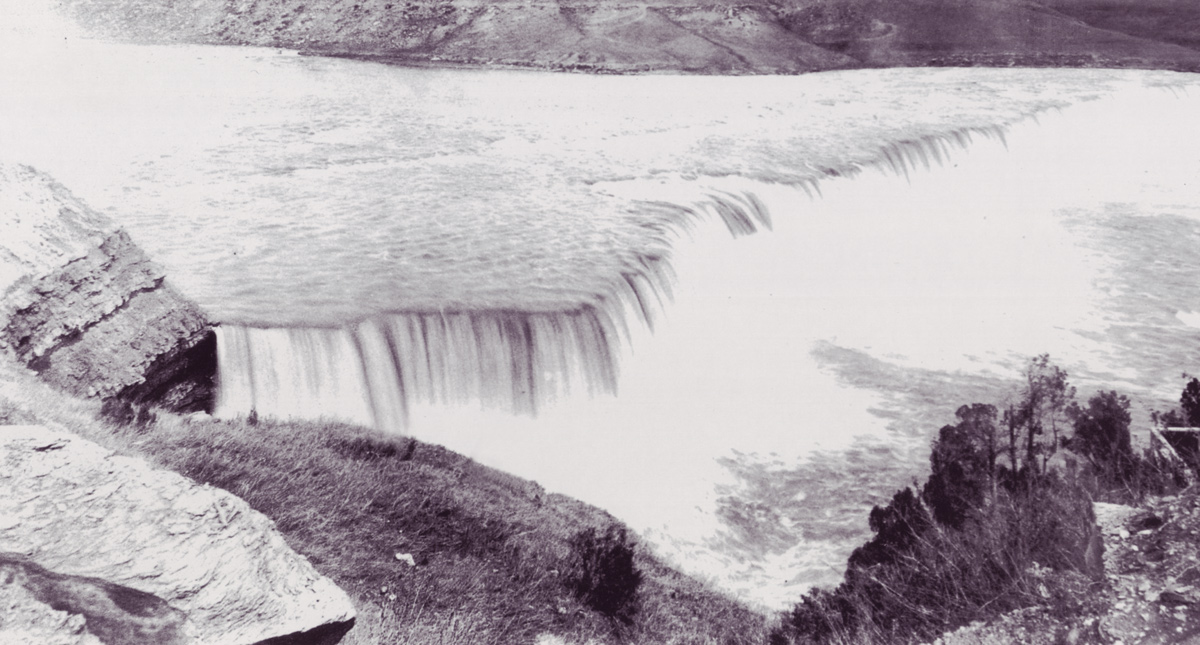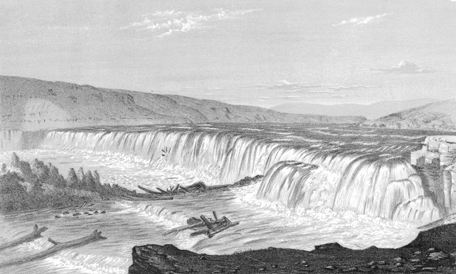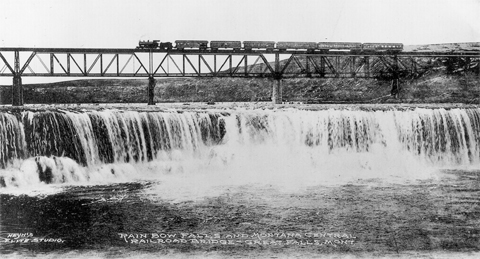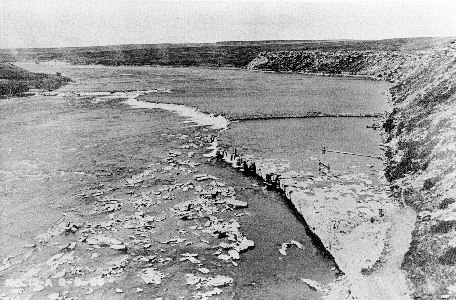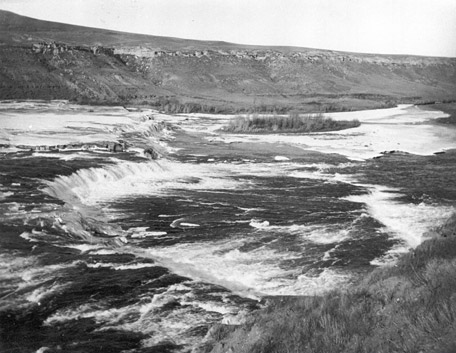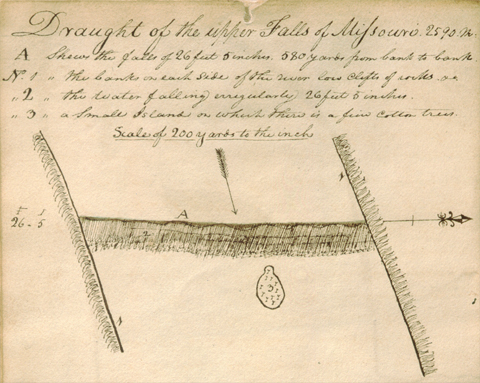From Indian information the previous winter, the captains knew they would encounter a great falls in the Missouri River. What they found was a 14-miles long series of waterfalls and rapids that drops 473 feet. It would take them several days to scout each waterfall and survey a route to portage the dugout canoes. The first water fall they encountered was, Grand Fall, the largest of five.
The Grand Fall
Nineteen-eight was one of those exceptional years when the spring runoff usurped that “channel of 40 yds” (bottom of photo), which Lewis walked across. It was long remembered as the year of “The Mother Flood.” On 14 June 1908, the stream flow at Fort Benton, thirty-five miles downriver, was measured at 140,000 cubic feet per second. By the seventeenth, when this photo was taken, the flow had slackened to 120,000 cfs. For comparison, the daily mean flow at a gauge upriver from the falls, during a forty-six-year period in the late 20th century, was 5,971 cfs.[1]USGS Water Resources of Montana, http://waterdata.usgs.gov/mt/nwis/measurements.
On 13 June 1805, two days after leaving William Clark with the boats at Decision Point, Meriwether Lewis wrote a detailed description of “this majestically grand scenery,” and even sketched “some of the stronger features of this seen” (the sketch has never been found), in hope that he could “give to the world some faint idea of an object which at this moment fills me with such pleasure and astonishment.”[2]See also Lewis at the Great Fall.
“I took my position on the top of some rocks about 20 feet high opposite the center of the falls,” wrote Lewis. He continued,
this chain of rocks appear once to have formed a part of those over which the waters tumbled, but in the course of time has been seperated from it to the distance of 150 yards lying prarrallel [sic] to it and forming a butment against which the water after falling over the precipice beats with great fury; this barrier extends on the right to the perpendicular clift which forms that board of the river but to the distance of 120 yards next to the clift it is but a few feet above the level of the water, and here the water in very high tides appears to pass in a channel of 40 yds. next to the higher part of the ledg of rocks; on the left it extends within 80 or ninty yards of the lard. Clift which is also perpendicular; between this abrupt extremity of the ledge of rocks and the perpendicular bluff the whole body of water passes with incredible swiftness.
During his extended exploration of the falls on 14 June 1805, Lewis discovered that a portage around the falls on the north side of the Missouri, which Indians back at Fort Mandan had recommended, “will be attended by much difficulty in consequence of several deep ravines which intersect the plains nearly at right angles with the river to a considerable distance, while the south side appears to be a delightfull smoth unbroken plain; the bearings of the river also make it pobable that the portage will be shorter on that side than on this.”
When Clark caught up with him on the sixteenth, the two of them discussed the situation. Early in the morning of 17 June 1805, while Lewis supervised preparations for the portage, made some celestial observations, and monitored Sacagawea‘s slow recovery from a serious illness, Clark set out to look for a likely portage route on the south side of the river. Taking five men to help him, he made a detailed inventory of the falls and rapids that Lewis had observed on the thirteenth and fourteenth. The summary of his discoveries is represented by the sketch map he drew of the falls, and its refinement in the engraving that accompanied the first edition of the Journals.
For another perspective, see The Great Fall by Air
The Rapids
This stretch of rapids and pitches is nearly three miles above Grand Falls, and a little over one mile below Crooked Falls. It could be the “Rapids and cascade of about 10 feet descent” that Clark indicated on his map of the falls, below the “Deep Ravine.”
On 15 June 1805, Lewis had noted the significance of the ravines seen in this photo.
I had discovered from my journey yesterday that a portage on this side of the river will be attended by much difficulty in consequence of several deep ravines which intersect the plains nearly at right angles with the river to a considerable distance, while the South side appears to be a delighfull smoth unbroken plain; the bearings of the river also make it p[r]obable that the portage will be shorter on that side than on this.
The ravines downstream near the Grand Falls are even deeper and longer than these.
At left, on the horizon, is the smokestack built in 1908 by the Anaconda Copper Mining Company to vent sulfurous fumes from the smelter built at Black Eagle Falls in the early 1890s. It was demolished in 1938.
Crooked Falls
At about ten o’clock on the morning of 14 June 1805, Captain Lewis took his gun and his espontoon and set out on a short walk up the north side of the river (at right in this photo), to see how far the rapids extended above the “grand Fall.” With the Hidatsas‘ assurance of a half-day portage still in mind, he fully expected he would be back at camp by noon.
After passing one continued rapid and three small cascades of about four or five feet each[,] at the distance of about five miles I arrived at a fall of about 19 feet; the river is here about 400 yds wide. this pitch which I called the crooked falls occupys about three fourths of the width of the river, commencing on the south side, extends obliquly upwards about 150 yds.[,] then forming an accute angle extends downwards nearly to the commencement of four small Islands lying near the N. shore; among these Islands and between them and the lower extremity of the perpendicular pitch being a distance of 100 yards or upwards, the water glides down the side of a sloping rock with a volocity almost equal to that of it’s perpendicular decent.
For a time, later in the nineteenth century, it seemed to some viewers that “horseshoe fall,” would be more descriptive, but Lewis’s name has prevailed. The islands and sloping rock Lewis noted have been obliterated by the in-fill on the north bank, which covers three large pipes that carry water from an intake above Rainbow Falls to a powerhouse a short distance below Crooked Falls.
Just above these falls, the captain continued, “the river makes a suddon bend to the right or Northwardly. I should have returned from hence but hearing a tremendious roaring above me I continued my rout across the point of a hill a fiew hundred yards further.”
The following week, Clark spent three days surveying the river from the mouth of Portage Creek to White Bear Islands. He measured each of the five major falls and seventeen separate rapids, cataracts, and pitches, calculating that the river “experience[d] a decent of 360 feet 2 inches and ¾” in a distance of 15 miles.
For another perspective, see Crooked Falls by Air.
Rainbow Falls
Lewis’s Description
Lewis’s admiration of the Crooked Falls on the morning of 14 June 1805 was interrupted by his awareness of “a tremendious roaring above me.” He made his way “across the point of a hill a few hundred yards further and was again presented by one of the most beautifull objects in nature.” It was “a cascade of about fifty feet perpendicular streching at right angles across the river from side to side to the distance of at least a quarter of a mile.”
here the river pitches over a shelving rock, with an edge as regular and as streight as if formed by art, without a nich or brake in it; the water decends in one even and uninterupted sheet to the bottom wher dashing against the rocky bottom rises into foaming billows of great hight and rappidly glides away, hising flashing and sparkling as it departs[.] the sprey rises from one extremity to the other to 50 f[eet].
I now thought that if a skillfull painter had been asked to make a beautifull cascade that he would most probably have pesented the precise immage of this one; nor could I for some time determine on which of those two great cataracts to bestoe the palm, on this or that which I had discovered yesterday;
at length I determined between these two great rivals for glory that this was pleasingly beautifull, while the other was sublimely grand.
Alfred E. Mathews’ Description
This picture, artist Alfred E. Mathews explained,[3]Alfred Edward Mathews (1831-1874), Pencil Sketches of Montana (New York: published by the author,1868). “represents the second principal fall, seven miles below the mouth of Sun River, and about ten miles from the stage road.[4]The “stage road” would have been the Mullan Road, pioneered and initially built under the direction of Lieutenant John Mullan, of the Corps of Topographical Engineers. It connected Fort … Continue reading The middle and left hand side of the fall has a descent of forty feet, while the right hand side consists of a succession of four falls (three of which are seen in the picture) with an island separating them from the main volume of water on a lower level.”
F. Jay Haynes’ Description
Stereographic Photo of Rainbow Falls
by Frank Jay Haynes, 1880
Haynes Foundation Collection, Montana Historical Society, H-324.
F. Jay Haynes‘s stereograph of the fall, taken in 1880, strikingly confirms Lewis’s first impression of this “pleasingly beautiful” object: “here the river pitches over a shelving rock, with an edge as regular and as streight as if formed by art . . . I now thought that if a skillful painter had been asked to make a beautifull cascade that he would most probably have pesented the precise immage of this one.” The photo is thought to be the first taken of Rainbow Falls.
Rainbow Falls in 1902
A Montana Central Railroad passenger train crosses the Missouri River above Rainbow Falls (‘Handsom’ Falls), about 1902. Rainbow Dam, situated between the falls and the bridge, was begun in 1908 and completed in 1910.
The antecedents of the steam-powered locomotive pictured above were Thomas Newcomen’s steam-powered pump, of 1705, and James Watt’s improvements on it in 1763. Both, larger than this locomotive, and far less powerful, were developed in Great Britain. The first steam locomotive was put into operation in Wales in 1804, in the service of the mining industry.
The first practical railroad service—with a permanent roadbed of iron rails set on wooden ties, over which a steam-powered locomotive pulled freight- and passenger-cars riding on flanged steel wheels—was put into operation in England in 1825. The history of railroads in the U.S. began five years later, when the Baltimore and Ohio Railroad was established to meet the rapidly increasing demand for faster, more economic transportation of goods and passengers than the Erie Canal could provide.
As the technology of the new mode of long-distance transportation improved, rails and steam reached farther and farther westward, especially after the Civil War. By 1869 the Union Pacific Railroad connected the Mississippi Valley with the Pacific Coast. The Atchison, Topeka and Santa Fe RR opened commercial traffic through the Southwest in 1880.
The first railroad through the Northwest, some of it paralleling Lewis and Clark’s water-level path, was the Northern Pacific, completed in 1883. Ten years later, James J. Hill’s Manitoba Railroad, later called the Great Northern, spanned the northwestern prairies and mountains from Minneapolis to Puget Sound. Meanwhile, the Utah and Northern Railroad connected the Union Pacific with the copper-mining city of Butte, Montana.
The Montana Central Railroad bridge seen here was built across the Missouri River above Handsome Falls in 1901. That year, the Montana Central began linking J. J. Hill’s Great Northern Railway mainline, near the Canadian border, with Butte, 125 miles southwest of Great Falls.
In the United States, the last steam locomotive was built in 1953. Some of the former Montana Central trackage today is used by the Burlington Northern-Santa Fe Railroad; the rest has been abandoned.
Railroads facilitated settlement of the West by stimulating the growth of cattle ranching and wheat farming, as well as the mining and lumber industries, and providing access to markets in the eastern U.S. and Europe. They also connected the U.S. with markets on the Pacific Rim. That was the objective that had driven generations of entrepreneurs and explorers to search for—as Jefferson put in his instructions to Lewis—”the most direct & practicable water communication across this continent for the purposes of commerce.”[5]Donald Jackson, ed., Letters of the Lewis and Clark Expedition with Related Documents, 1783-1854 (2nd ed., 2 vols.; Urbana: University of Illinois Press, 1978), 1:61.
For another perspective, see Rainbow Falls by Air
Colter Falls
This photo probably was taken in late 1908. To gain a sense of the scale of this waterfall, find the six workmen at right of center [point to the image]. They are building a shear dam to divert the river away from the north side of the channel so that work can begin on the intake, power house, and tailrace for the Rainbow Dam. Since 1910, when the dam was completed, Colter Falls have been hidden from view beneath the reservoir’s surface.
“I had scarcely infixed my eyes from this pleasing object,” wrote Lewis—referring to the “handsom fall,”
before I discovered another fall above at the distance of half a mile; thus invited I did not once think of returning but hurried thither to amuse myself with this newly discovered object. I found this to be a cascade of about 14 feet possessing a perpendicular pitch of about 6 feet. this was tolerably regular stretching across the river from bank to bank where it was about a quarter of a mile wide; in any other neighbourhood but this, such a cascade would probably be extoled for it’s beaty and magnifficence, but here I passed it by with but little attention, determining as I had proceded so far to continue my rout to the head of the rappids if it should detain me all night.
During his survey of the falls on 19 June 1805, Clark calculated the south end of this “pleasing object” was “N 86° W. 135 poles,” or 2,227 feet upstream from the “2d great falls,” or “handsom falls.” Sometime in the 1880s Paris Gibson, the founder of the city of Great Falls, named it for John Colter, who was a member of Clark’s survey party.[6]Paris Gibson, “The Falls of the Missouri: Their Past, Present and Future,” Rocky Mountain Magazine, Vol. 1, No. 1 (September 1900).
Black Eagle Falls
Hidatsa Confirmation
On the afternoon of 14 June 1805, proceeding two and one-half miles upriver from the “Cascade of 14 feet 7 in. in descent” (later named Colter Falls), Lewis arrived at the uppermost cascade:
this is not immediately perpendicular, a rock about 1/3 of it’s decent seems to protrude to a small distance and receives the water in it’s passage downwards and gives a curve to the water tho’ it falls mostly with a regular and smoth sheet. the river is near six hundred yards wide at this place, a beautifull level plain on the S. side only a few feet above the level of the pitch; on the N. side where I am the country is More broken and immediately behind me near the river a high hill.
His next discovery provided absolute confirmation that he and Clark had made the right decision at the mouth of Maria’s River, three days before. Finally he had found the evidence the Hidatsas had told them of:
below this fall at a little distance a beautifull little Island well timbered is situated about the middle of the river. in this Island on a Cottonwood tree an Eagle has placed her nest; a more inaccessable spot I beleive she could not have found; for neither man nor beast dare pass those gulphs which seperate her little domain from the shores.
Clark’s First View
Clark, completing his survey trip up the south side of the river on 18 June 1805,
proceeded on up the river passed a Succession of rapids to the next great fall of 26 Ft. 5 I[nches]. river 580 yards wide this fall is not intirely perpdincular a Short bench gives a Curve to the water as it falls a butiful Small Island at the foot of this fall near the Center of the Channel Covered with trees, the Missouri at this fall is 36 yards wide, a Considerable mist rises at this fall ocasionally, from this pitch to the head of the rapids is one mile & has a fall of 20 feet, this is also a handsome Scenery a fall in an open leavel plain, after takeing the hight & measureing the river proceeded on.
The Eagle’s Nest
Captain William F. Raynolds, of the Corps of Topographical Engineers, passing this way in command of a U.S. government expedition in 1860, reported that there was still an eagle’s nest in a cottonwood tree on the island. Moreover, he observed a specimen of “this peculiarly American bird” perched in a nearby tree, and thought it might be the very same bird Lewis had seen 55 years before.[7]W. F. Raynolds, Report of the Exploration of the Yellowstone River (Washington, D.C.: Government Printing Office, 1868), 108. Unique to the continent of North America, Haliaeetus leucocephalus … Continue reading That is remotely possible, considering at least one captive black eagle is thought to have lived nearly fifty years during the mid-twentieth century, but the average age, even in 1805, was at least somewhat less.[8]John K. Terres, The Audubon Society Encyclopedia of North American Birds (New York: Wings Books, 1991), 477. In 1872 an engineer named Thomas P. Roberts led a party of seven men on a government-sponsored expedition down the Missouri from the Three Forks of the Missouri to Fort Benton to ascertain the river’s suitability for commercial navigation by light-draft steamboats. Roberts similarly noted an eagle’s nest in the remains of an old cottonwood tree on the island, and also saw a bald eagle. Getting a close look at it, he “had a good opportunity to judge the age of the bird, his feathers being soiled, torn, and otherwise old looking,” and concluded it probably was the same bird Lewis had seen. “The sight of this eagle was to me one of the most peculiarly pleasant incidents of our reconnoissance [sic].”[9]Thomas P. Roberts, “The Upper Missouri River,” Contributions to the Historical Society of Montana, Vol. 1 (1876), 230. Olin D. Wheeler, Trail of Lewis and Clark, 323, credits Roberts with … Continue reading
Black Eagle Falls Today
A writer from the Century Illustrated Monthly Magazine toured the falls of the Missouri in the autumn of 1887 and reported: “The appearance of the Black Eagle Fall suggests its future use. Some day it will drive saws, spindles, and mill-stones.”[10]Eugene V. Smalley, “The Upper Missouri and the Great Falls,” The Century Illustrated Monthly Magazine, Vol. 35 (New Series 13), No. 3 (January 1888), 415. Indeed, plans for harnessing the fall’s potential were already under way. The first dam, completed in 1891, provided both direct mechanical power and a limited amount of electricity for local use.
When the original (1891) Black Eagle Dam was replaced in 1928, the raceway, powerhouse, and tailrace permanently displaced the historic island and its avian population.
Commercial traffic on the Missouri River ended quickly with the completion of the first railroads across the northwest in the 1880s and 90s, so when the construction of dams began early in the 20th century—for flood control, irrigation and electrical power generation—there was no need to include locks through any of them. Today, pleasure boaters must portage around each of the fifteen mainstream dams on the Missouri, including the five at Great Falls.
Like all rivers in the Northwest, the Missouri is highest during spring and early summer, reaching its lowest ebb from late summer through late winter. This photograph, taken in October 2003 following an unusually dry summer, reveals the underlying geology of the falls that Lewis deemed a “noble and interesting object.” Significant advances had been made in the concept of stratigraphy, especially in America, even during the very years of the Lewis and Clark expedition, but the captains were unprepared to appreciate the history of those light-brown and red-brown sandstone layers beneath all the falls. Nor could they have yet known those rocks were 115-million-year-old products of the Cretaceous Period of the Mesozoic Era, when modern mammal and bird groups, along with the first flowering plants, also emerged. Later in the nineteenth century, geologists named these old riverbed sandstones the Kootenai Formation.[11]Museum of Paleontology, University of California, Berkeley, http://www.ucmp.berkeley.edu/mesozoic/mesozoic.html/ Moulton, 4:288n. John C. Greene, American Science in the Age of Jefferson (Ames: Iowa … Continue reading
Lewis’s Comparisons
This waterfall, Lewis wrote, “is certainly much the greatest I ever behald except those two which I have mentioned below”—obviously referring to the “handsom Fall” and the “grand Fall.” It was, he said, “incomparably a greater cataract and a more noble interesting object than the celibrated falls of Potomac or Soolkiln [Schuylkill] &c.” (He might also have mentioned—but never did—the Falls of the Ohio, which both he and Clark were quite familiar with, and had last navigated in late October 1803.)
Beck’s Great Falls of the Potomac
Great Falls of the Potomac
by G. Beck (c. 1748-1812)
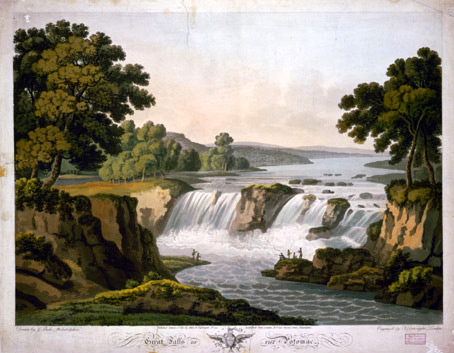
Library of Congress Prints and Photographs Division
Engraved by J. Cartwright, London. Aquatint, hand-colored; 1802.
The Great Falls of the Potomac River, fourteen miles upstream from Washington, D.C., consists of a series of cascades and rapids dropping a total of about seventy-six feet over a pitch of two-thirds of a mile, the greatest drop being about twenty feet.[12]“The Great Falls of the Potomac, Montgomery County.” Maryland Geological Survey, http://www.mgs.md.gov/esic/features/great.html.
Schuylkill Falls
The Falls of the Schuylkill
Detail from “Portrait of John Dickinson”

Courtesy Atwater Kent Museum of Philadelphia.
During the eighteenth and early 19th centuries the falls of the Schuylkill[13]Schuyl Kil, pronounced skoo-kul, is Dutch for “hidden stream.” River, four miles upstream from its once marshy confluence with the Delaware River, was the most famous natural attraction in the vicinity of Philadelphia, Pennsylvania, where its roar could be heard when the wind blew from the northwest. Schuylkill Falls was more like the Falls of the Ohio at Louisville than the Great Falls of the Missouri, inasmuch as boats could be guided thorugh its rocky hazards by skilled pilots.
Charles Willson Peale (1741-1827)[14] Peale also painted the well-known portraits of William Clark (1806) and Meriwether Lewis (1807)., the “patriarch of American painters of the Revolutionary period,” made a watercolor sketch of Schuylkill Falls before introducing it in Dickinson’s portrait to subtly identify the man with the city.[15]Martin P. Snyder, City of Independence: Views of Philadelphia Before 1800 (New York: Praeter Publishers, 1975), 86. Beginning in the 1790s the falls became a popular subject of drawings, magazine engravings, landscape paintings, and portraits such as this one. In 1821 Fairmount Dam was built a short distance downstream, and Schuylkill Falls was submerged in the backwater.
John Dickinson (1732-1808), the American statesman known as “the penman of the Revolution,” drafted the Articles of Confederation, and was a delegate to the Continental Congress. His book, Letters from an American Farmer in Pennsylvania to the Inhabitants of the British Colonies (1767-68), influenced support for Colonial independence both at home and abroad. He also wrote a popular song titled “A Song for American Freedom.” He signed the Constitution and, as a pamphleteer under the pseudonym Fabius, was an effective advocate for its adoption.
The author appreciates the assistance of Bill O’Keefe, formerly superintendent of Montana Power Company dams on the Missouri River.
Rainbow Falls is a High Potential Historic Site along the Lewis and Clark National Historic Trail managed by the U.S. National Park Service. An overlook of the falls is accessible by roadway or footpath, and the Lewis and Clark Interpretive Center is located about 1.5 miles to the west.—ed.
Notes
| ↑1 | USGS Water Resources of Montana, http://waterdata.usgs.gov/mt/nwis/measurements. |
|---|---|
| ↑2 | See also Lewis at the Great Fall. |
| ↑3 | Alfred Edward Mathews (1831-1874), Pencil Sketches of Montana (New York: published by the author,1868). |
| ↑4 | The “stage road” would have been the Mullan Road, pioneered and initially built under the direction of Lieutenant John Mullan, of the Corps of Topographical Engineers. It connected Fort Benton at the upstream limit of steamboat commerce on the Missouri River, with Fort Walla Walla, the eastern commercial terminus of the Columbia. See Marilyn Wyss, Roads to Romance (Helena: Montana Department of Transportation, 1992), 3-4. |
| ↑5 | Donald Jackson, ed., Letters of the Lewis and Clark Expedition with Related Documents, 1783-1854 (2nd ed., 2 vols.; Urbana: University of Illinois Press, 1978), 1:61. |
| ↑6 | Paris Gibson, “The Falls of the Missouri: Their Past, Present and Future,” Rocky Mountain Magazine, Vol. 1, No. 1 (September 1900). |
| ↑7 | W. F. Raynolds, Report of the Exploration of the Yellowstone River (Washington, D.C.: Government Printing Office, 1868), 108. Unique to the continent of North America, Haliaeetus leucocephalus (hal-ih-ay-EE-tus lew-koh-SEFF-ah-lus, meaning “sea-eagle with a white head”) is estimated to have numbered in the tens of thousands in 1782, when the species was adopted as the national emblem of the new United States. |
| ↑8 | John K. Terres, The Audubon Society Encyclopedia of North American Birds (New York: Wings Books, 1991), 477. |
| ↑9 | Thomas P. Roberts, “The Upper Missouri River,” Contributions to the Historical Society of Montana, Vol. 1 (1876), 230. Olin D. Wheeler, Trail of Lewis and Clark, 323, credits Roberts with naming Black Eagle and Rainbow Falls, as well as the Long Pool above the uppermost rapid, but Roberts himself does not claim that in his memoir, and there is no further evidence to substantiate it. |
| ↑10 | Eugene V. Smalley, “The Upper Missouri and the Great Falls,” The Century Illustrated Monthly Magazine, Vol. 35 (New Series 13), No. 3 (January 1888), 415. |
| ↑11 | Museum of Paleontology, University of California, Berkeley, http://www.ucmp.berkeley.edu/mesozoic/mesozoic.html/ Moulton, 4:288n. John C. Greene, American Science in the Age of Jefferson (Ames: Iowa State University Press, 1984), 218-252. |
| ↑12 | “The Great Falls of the Potomac, Montgomery County.” Maryland Geological Survey, http://www.mgs.md.gov/esic/features/great.html. |
| ↑13 | Schuyl Kil, pronounced skoo-kul, is Dutch for “hidden stream.” |
| ↑14 | Peale also painted the well-known portraits of William Clark (1806) and Meriwether Lewis (1807). |
| ↑15 | Martin P. Snyder, City of Independence: Views of Philadelphia Before 1800 (New York: Praeter Publishers, 1975), 86. |
Experience the Lewis and Clark Trail
The Lewis and Clark Trail Experience—our sister site at lewisandclark.travel—connects the world to people and places on the Lewis and Clark Trail.
Discover More
- The Lewis and Clark Expedition: Day by Day by Gary E. Moulton (University of Nebraska Press, 2018). The story in prose, 14 May 1804–23 September 1806.
- The Lewis and Clark Journals: An American Epic of Discovery (abridged) by Gary E. Moulton (University of Nebraska Press, 2003). Selected journal excerpts, 14 May 1804–23 September 1806.
- The Lewis and Clark Journals. by Gary E. Moulton (University of Nebraska Press, 1983–2001). The complete story in 13 volumes.
